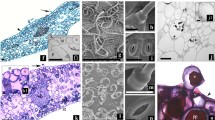Abstract
Sections of young leaves with typical “spike” symptoms did not show any differentiation into palisade and spongy parenchyma tissue. Moreover, the regular structure of the vascular bundles was sometimes slightly disturbed and often necrotic cells occurred both in the phloem and in the cambial zone.
Cross sections of diseased stems showed that the organisation of the phloem, medullary rays and sometimes also of the cambial layers was disturbed. Besides, numerous groups of necrotic cells could be observed in the phloem and, less frequently, in the cambial layers.
Longitudinal sections of diseased stems stained with methyl green-pyronin showed an accumulation of blue material. As even at a magnification of x 1500 no differentiation of the blue material could be obtained, the latter might consist of accumulated DNA fromMycoplasma-like organisms having lost their original structure, as a result of the fixation and embedding techniques used.
Samenvatting
Voor kleuring van de 8 of 12 μ dikke microtoomcoupes van stengels en bladeren werden meestal methylgroen-pyronine en toluïdineblauw gebruikt; enkele bladcoupes werden ook met Heidenhain's hematoxyline gekleurd.
Dwarsdoorsneden van jonge, gezonde sandelbladeren (Fig. 1A) en jonge, zieke bladeren (Fig. 1B) werden met elkaar vergeleken. Opmerkelijk was, dat in het laatste geval de differentiatie tussen palissade-en sponsparenchym was verdwenen. Verder was de regelmatige opbouw van de vaatbundels enigszins verstoord. Vaak werden in floëem en cambiale lagen necrotische cellen waargenomen.
Bij vergelijking tussen gezonde stengels (Fig. 2A) en zieke (Fig. 2B) bleek in de zieke stengels de organisatie van floëem, mergstralen en soms ook de cambiale lagen verstoord te zijn. Voorts waren in deze weefsels groepjes necrotische cellen zichtbaar.
Lengtedoorsneden van zieke stengels, die gekleurd waren met methylgroen-pyronine, vertoonden sterk gekleurde gedeelten in de zeefvaten, vooral in de buurt van de zeefplaten. Bij een vergroting van 1500 x werden zowel bij gezonde als zieke stengels in deze gebieden korrelige structuren gevonden. het enige verschil was, dat bij de zieke een gedeelte van deze sterk gekleurde gebieden een blauwe kleur vertoonde en voor de rest rood was, terwijl bij het gezonde materiaal alleen de rode kleur aanwezig was. Dit zou kunnen wijzen op een ophoping van DNA in het floëem van zieke stengels.
Similar content being viewed by others
References
Barber, C. A., 1903. Report on spike disease in sandalwood trees in Coorg. Indian Forester 29:21–31.
Borges, M. de Lourdes V. & David-Ferreira, J. F., 1968. Presence of Mycoplasma in Lycopersicon esculentum Mill. with ‘Mal Azul’. Bolm Soc. broteriana Sér. 2A, 42:321–333.
Butler, E. J., 1903., Report on “spike” disease among sandalwood trees. Indian Forester 29 (Appendix, Ser. 1): 1–11.
Coleman, L. C., 1917. Spike disease of sandal. Bull. Dep. Agric. Mysore, Mycol. Ser. 3:1–52.
Dijkstra, J., 1968. The occurrence of inclusion bodies in leaf epidermal cells of sandal affected with spike disease. Neth. J. Pl. Path. 74:101–105.
Dijkstra, J. & Ie, T. S., 1969. Presence of Mycoplasma-like bodies in the phloem of sandal affected with spike disease. Neth. J. Pl. Path. 75:374–378.
Narasimhan, M. J., 1933. Cytological investigations on the spike disease of sandal, Santalum album. Phytopathology 23:191–202.
Rangaswami, S. & Sreenivasaya, M., 1935. Insect transmission of spike disease of sandal (Santalum album Linn.) Curr. Sci. 4:17–19.
Varma, A., Chenulu, V. V., Raychaudhuri, S. P., Prakash, N. & Rao, P. S., 1969. Mycoplasma-like bodies in tissue infected with sandal spike and brinjal little leaf. Indian Phytopathology 22:289–290.
Author information
Authors and Affiliations
Rights and permissions
About this article
Cite this article
Dijkstra, J., van der Want, J.P.H. Anatomical aspects of sandal plants affected with spike disease. Netherlands Journal of Plant Pathology 76, 174–178 (1970). https://doi.org/10.1007/BF01974327
Accepted:
Issue Date:
DOI: https://doi.org/10.1007/BF01974327




